The impact of cane toads in Australia
What impact do cane toads have on biodiversity in Australia? Many people think it's a catastrophe when toads arrive - but what is the evidence?
Surveys of public opinion often suggest that Australians see cane toads as the worst invasive species in this country – worse even than scourges like rabbits, foxes, cats, pigs, goats, camels and the like. It’s not obvious why people react so strongly to toads – a lot of it seems to be related to an emotional reaction – “YUK, THEY’RE DISGUSTING!!” It’s puzzling to people from other countries where toads of one kind or another are common native species (in Europe, Africa, Asia, and North and South America). Perhaps because most other types of toads are much smaller than cane toads, plus the fact that the local toads “belong there”, these little warty animals often are regarded with affection. It’s hard to find that affection in Australia towards cane toads!
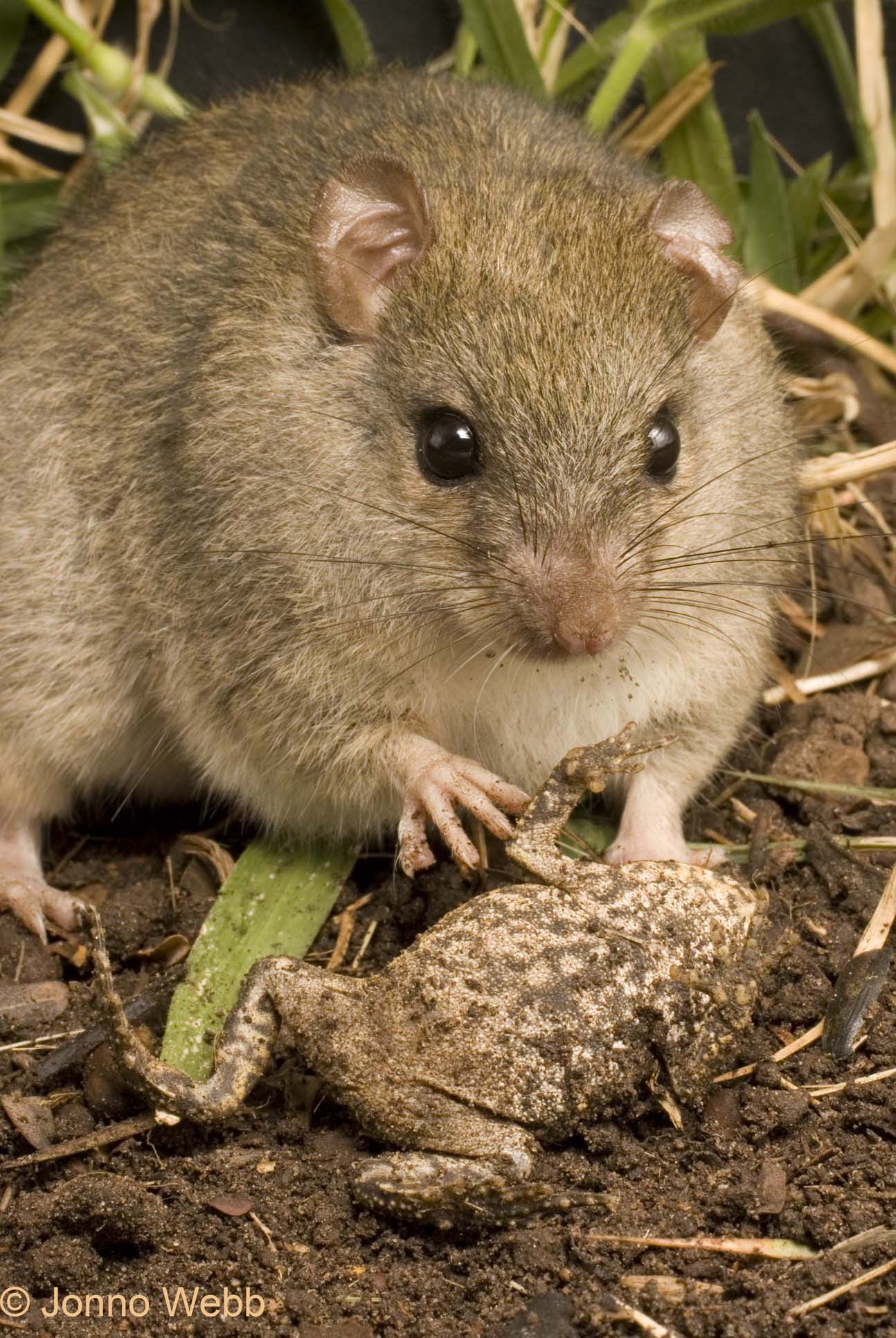
For this small native rat, a cane toad is a delectable meal rather than a dangerous one. Most rodents can handle the poisons of cane toads without any ill effects. Photo by Jonno Webb.
Impacts of cane toads on people
Emotional reactions
Rachael Clark and her colleagues recently conducted surveys to ask the Australian public WHY they hate cane toads so much. Until then, all we had to go on was a general feeling from talking to lots of people about cane toads (taxi drivers, for example, almost always seem to have strong opinions about these animals!). And the main result to emerge from those conversations was the YUK factor – people just don’t like cane toads, full stop.
For most people, that is unpleasant but it's not a big deal. However, some people become deeply concerned about cane toads. That can develop into fullblown anxiety, a serious medical issue. And even if the symptoms are not too severe, knowing that cane toads come out in the garden at night can keep some people inside the house - so it affects their quality of life. The solution here is to learn a bit more about toads, and recognise that they are never aggressive. Indeed, cane toads are not dangerous unless you attack the toad and make it expel the poison from its shoulder glands. If you leave cane toads alone, they will leave you alone!
Dangers to people's health
We’ve heard lots of stories about youngsters in remote communities licking cane toads as a form of drug abuse. So far as we know, these are just stories. It doesn't happen in the small towns where we work.
We only know of one reliable account of an Aussie being kileld by a cane toad. The documentary movie "Cane Toads- The Conquest" told of a man being electrocuted when he hit a live wire when trying to stab a cane toad with a home-made spear ... but it's a bit cruel to blame the toad for that tragedy.
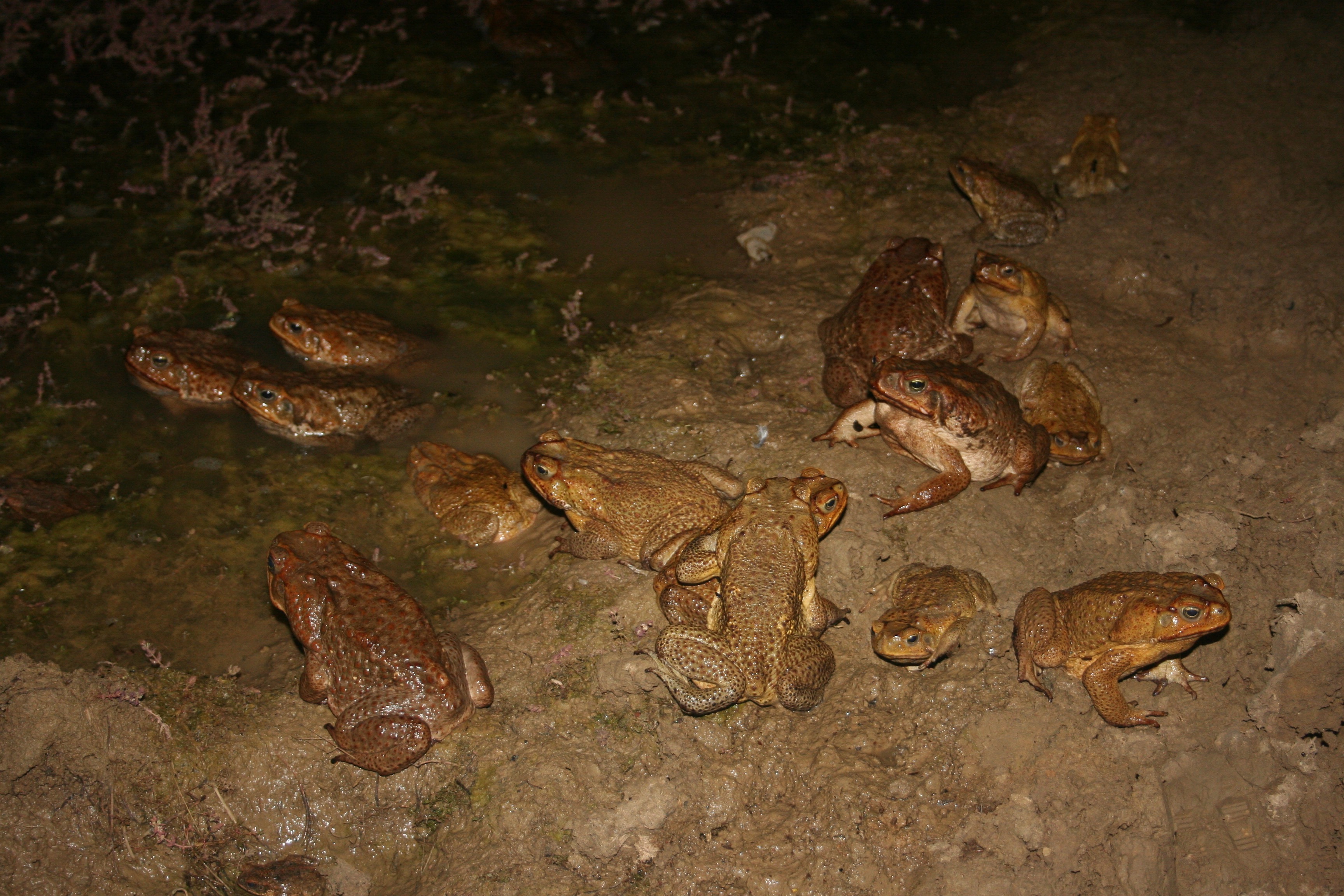
Cane toads can occur in very high abundance near the invasion front, especially during the tropical dry-season when all of the local toads are forced together at the few remaining sources of water. Matt Greenlees took this photograph beside a drying pond near Longreach in western Queensland.
Dangers to domestic pets
Dogs and cats may pick up a cane toad if they find one in the backyard. This is most likely to happen at night, when toads are more active.
If the animal bites down on the toad, it may receive a dose of powerful poison into its mouth, as the white toxin is squeezed out of the toad’s shoulder glands. If the toxin is swallowed, or absorbed through mucous membranes such as those of the eyes, nose and mouth, then severe symptoms can occur very rapidly. The pet is likely to begin drooling and shaking its head. Cats often begin vomiting, become weak in their hind legs, and adopt a fixed stare. Severe shaking and trembling are common also.
Dogs that have been poisoned begin to stagger around, may have difficulty in breathing, and go into convulsions. Unless you can obtain medical attention, these are likely to be fatal because they end up causing a heart attack.
You can improve your pet’s chances of survival by flushing out the poison with fresh water. Point a hose forward (so the water doesn’t run down the pet’s throat) and tilt the animal’s head down so it doesn’t choke. Try to remove all traces of poison from the gums and teeth, and wash out the eyes as well.
Treatment for people is pretty similar. Wash out the poison with fresh water, and get the person to hospital. People have died from cane toad poisoning, so it’s a serious matter.
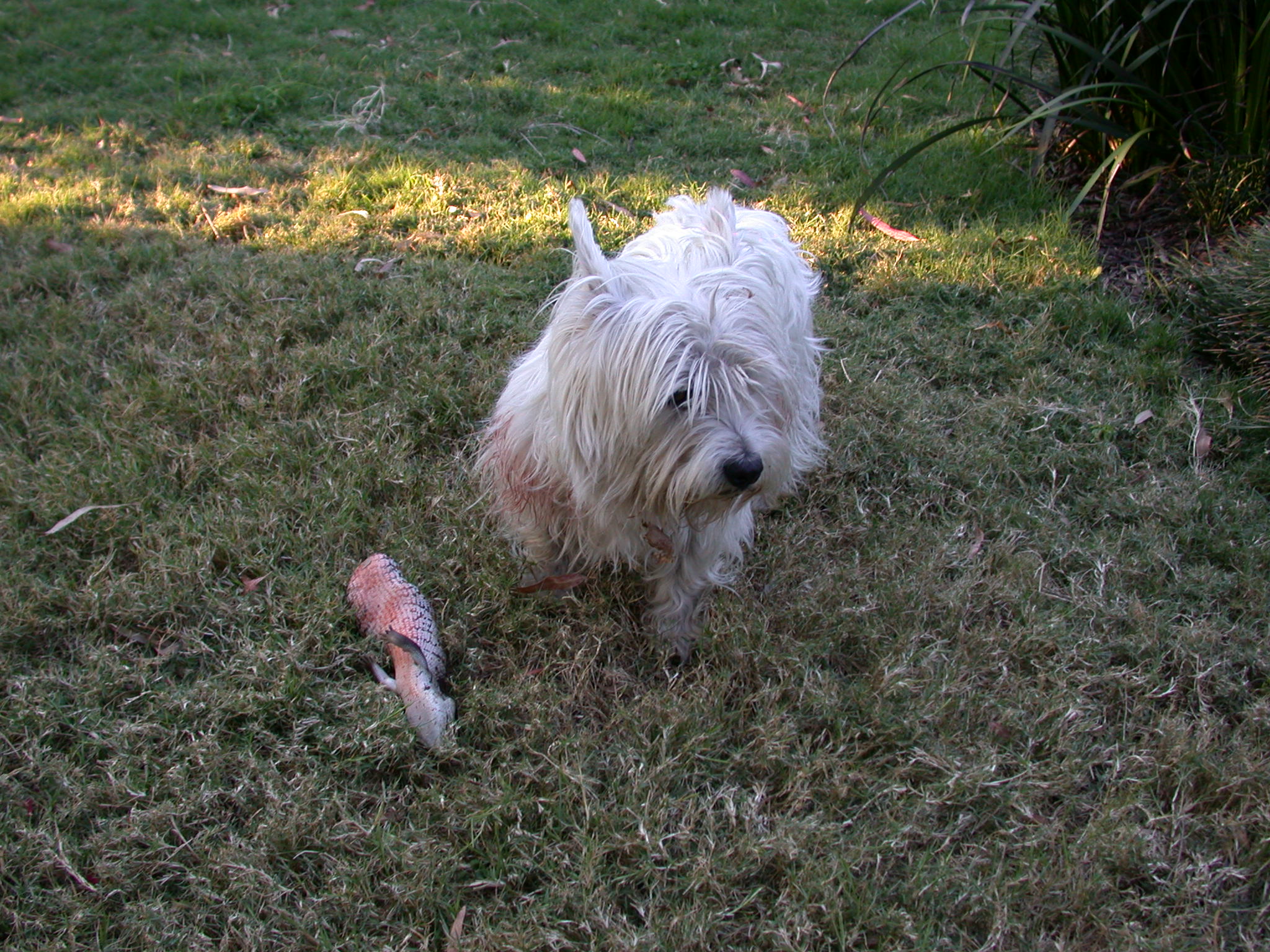
Terriers are lovable pets, but can be very aggressive towards any small animals in the backyard. Sometimes the victim is a harmless Bluetongue Lizard, as in this photo. But if the target is a cane toad, the terrier is at risk of fatal poisoning. Photo by Rick Shine.
Economic costs
Many species of pests (like rabbits and leaf-eating insects) impose a major commercial cost by reducing profitability of agricultural enterprises. That’s not a big deal with toads, though. People who produce salad plants complain that small toads get caught up with the lettuce and spinach when it is harvested, requiring extra effort to sort the crop. And bee-keepers often complain that toads eat so many bees that it affects honey production. For that reason, most bee-hives in toad-infested areas are up on stilts to keep the bees above the toads. TEAM BUFO student Renee Silvester looked into this issue. Sure enough, the toads do eat bees – but not enough to really affect the hive.
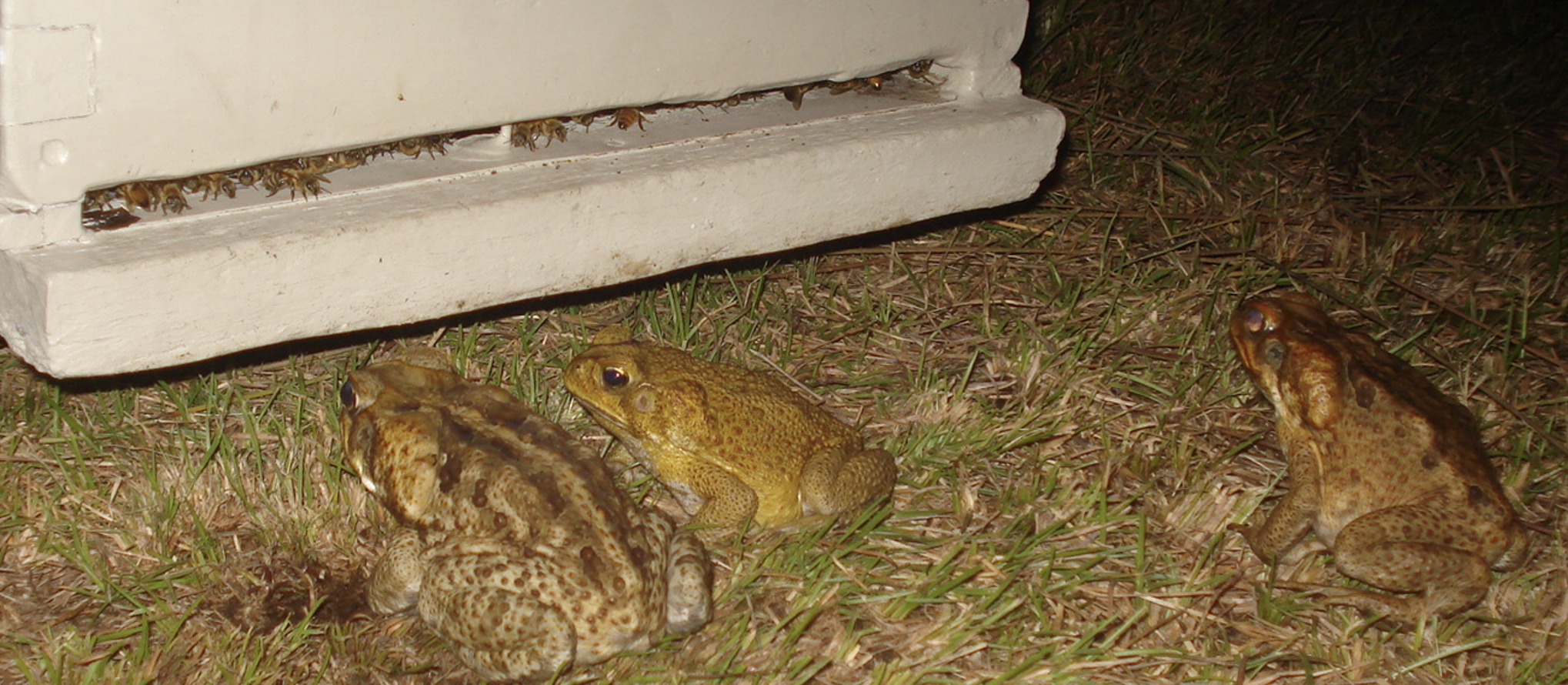
These toads have gathered around the entrance to a beehive, to catch and eat bees as they emerge and return to the hive. Photo by Matt Greenlees.
Impacts of cane toads on wildlife
If pushed to come up with a reason why cane toads are a problem in Oz
(other than “THEY ARE SOOOO UGLY!”), most people talk about ecological
impacts on the native fauna. That is, toads are widely believed to kill
many native animals, or to eat them, and so cause a major ecological catastrophe in the
areas they invade. Some of the community groups have suggested that
toad invasion has incredibly serious effects on the native fauna.
Surprisingly, although cane toads eat a lot, predation by the toads doesn't seem to be too much of an issue. Cane toads mostly eat small insects like beetles and ants, and they don't take enough of them to really affect insect populations - although we don't know for certain, and it could be a problem in some situations. For example, cane toads love to eat dung beetles. These beetles play an important role in breaking down piles of dung left by cattle - and the toads disrupt that important ecological function by eating the beetles. As a result, the dung piles remain intact, killing the grass over significant areas.
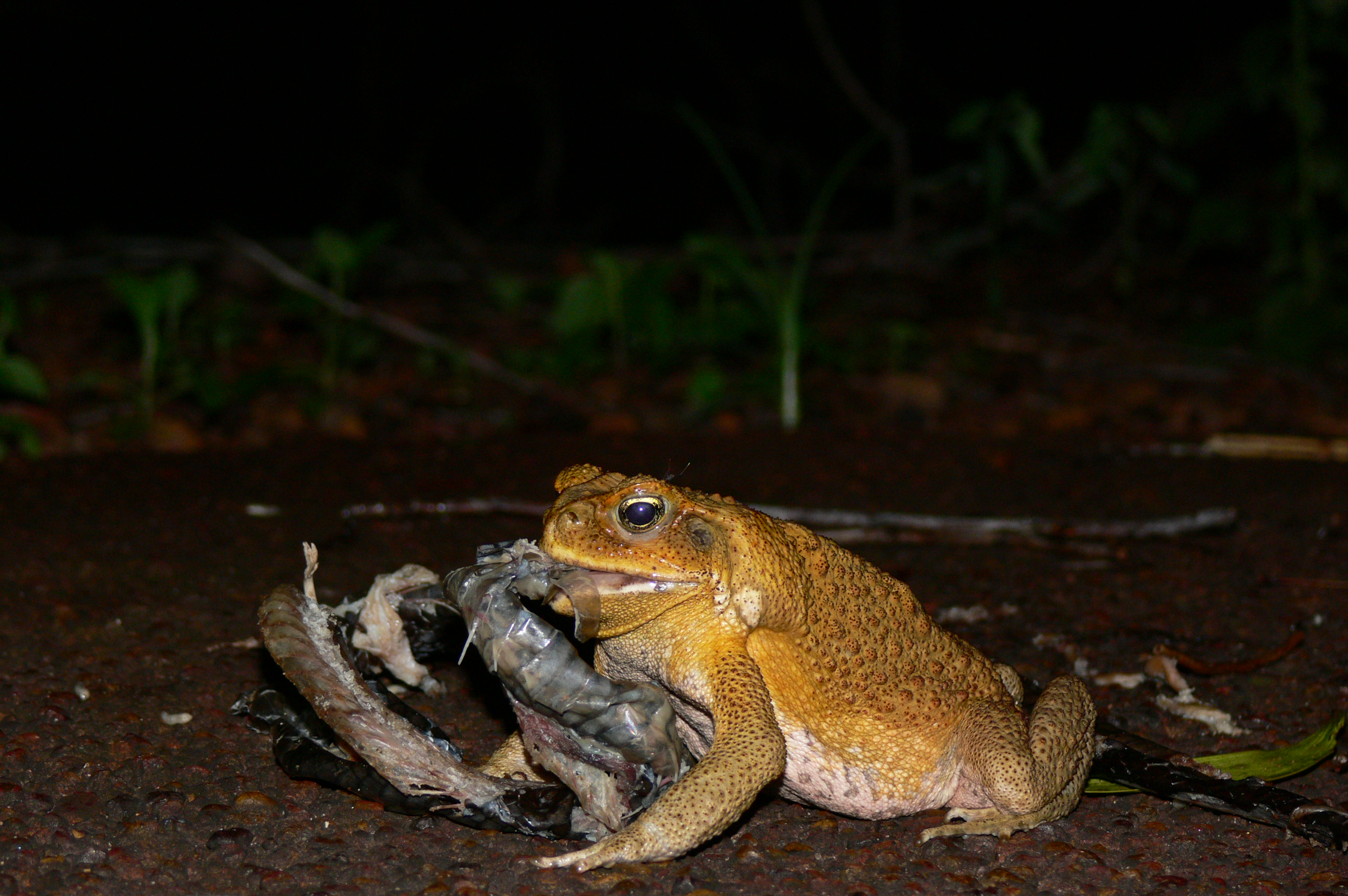
Although cane toads mostly eat tiny insects, a hungry toad will try almost anything for dinner. Crystal Kelehear photographed this one eating a road-killed snake.
Another ecological impact of toads is an indirect one. Goannas (varanid lizards) are important scavengers as well as predators in Australian ecosystems. Many people have seen goannas feeding on animals like kangaroos that have been hit by vehicles and left beside the road. Because many of the local goannas are fatally poisoned by cane toads, the arrival of toads removes most of the scavengers. As a result, dead animals and other refuse lies around instead of being recycled.
But the major problem, by far, is that cane toads are highly poisonous. They have types of poison very different from that produced by Australian frogs. There are no native toads in Australia, so our predators have not evolved to cope with those distinctive toad poisons. An Australian predator that meets its first toad is likely to think it has found a large tasty frog .. but eating that new amphibian, or even holding it in the mouth for a few seconds, may be enough to cause a fatal heart attack for the predator.
The kinds of
native animals that are most likely to be affected by toads are big
predators, like quolls (marsupial carnivores), large snakes, and
goannas. They eat frogs, but can’t handle the poisons in cane toads,
and so are killed when they try to eat the poisonous new froglike
animal.But actually measuring that impact is difficult. Because big predators are usually rare and secretive,
we don’t know how many are out there in the bush BEFORE toads arrive –
and so don’t know how many have been killed by toads. It’s
clear that many predators ARE killed by toads – we often find them lying
dead with a toad in their mouth or stomach – but the question is, what
proportion of the predator population is killed?
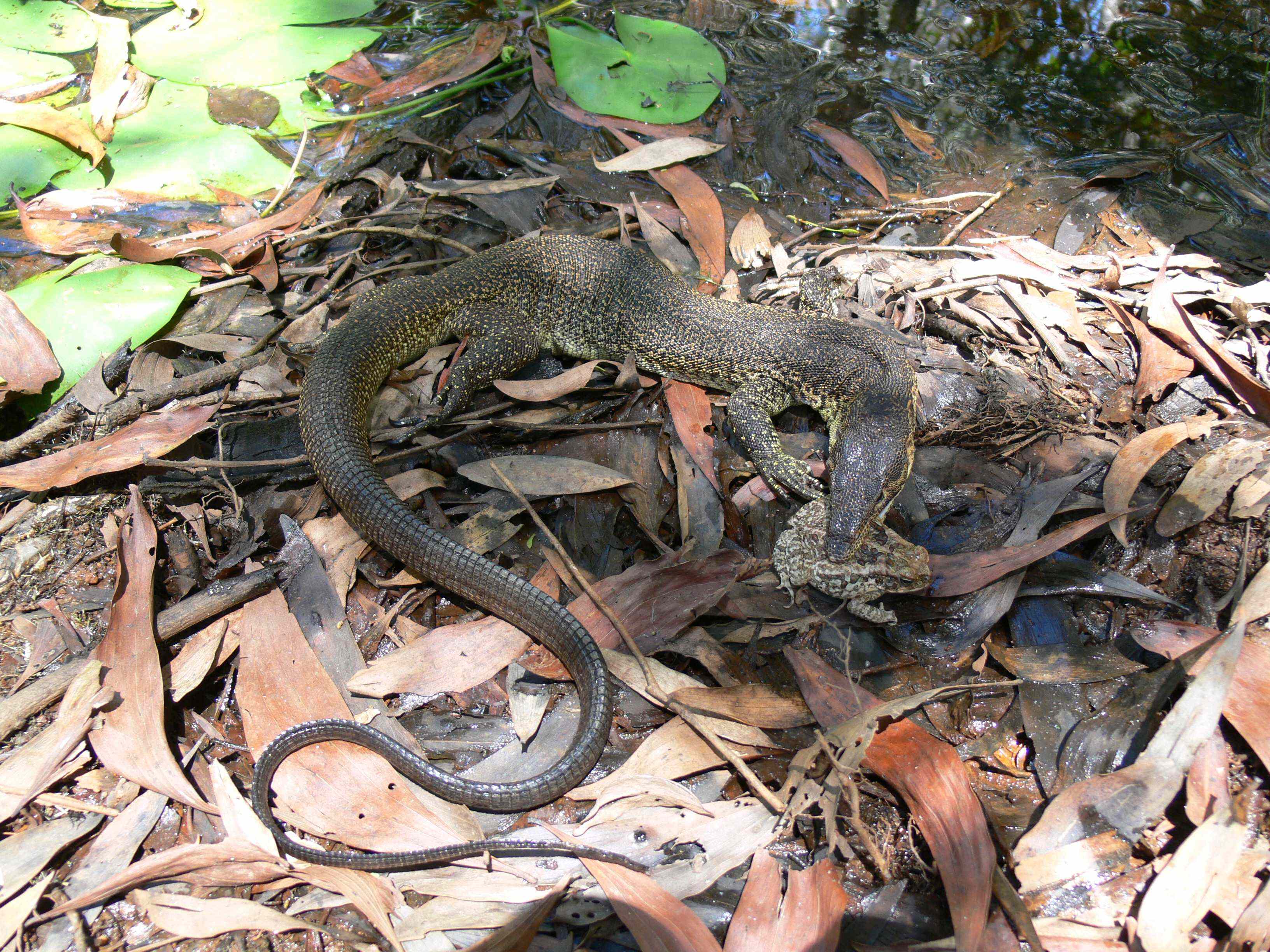
This Mitchell's Water Monitor was fatally poisoned by a cane toad it tried to eat.
Photo by Michelle Franklin.
Sometimes, it’s a lot! From work by Professor Thomas Madsen and Dr Beata Ujvari at Fogg Dam, as well as Dr Greg Brown’s regular counts, we know that most of the big floodplain goannas were killed by trying to eat toads, within a year or so of the toads first arriving. It’s likely that around 90% of the adult goannas may have died in this way – a huge impact. Surveys by Dr Sean Doody and his colleagues show the same situation on the Daly River. Dr Ben Phillips’ work on the Fogg Dam death adders indicates very high mortality also – perhaps 10% or so within a year of toad arrival. In her radio-tracking work, Dr Meri Oakwood has found similarly high mortality in quolls (carnivorous marsupials). One of TEAM BUFO'S researchers, Stephanie O'Donnell, has also been radio-tracking quolls - and like Meri, has concluded that cane toads are a real threat to these attractive marsupials. And in our studies in upstream areas of the Daly and Victoria Rivers (but not in downstream areas like Fogg Dam), lots of freshwater crocodiles are killed when they try to eat toads.
In northeastern New South Wales, at the southern front of the toad invasion, Chris Jolly has found similar dramatic declines in lizard numbers when toads arrive in an area.
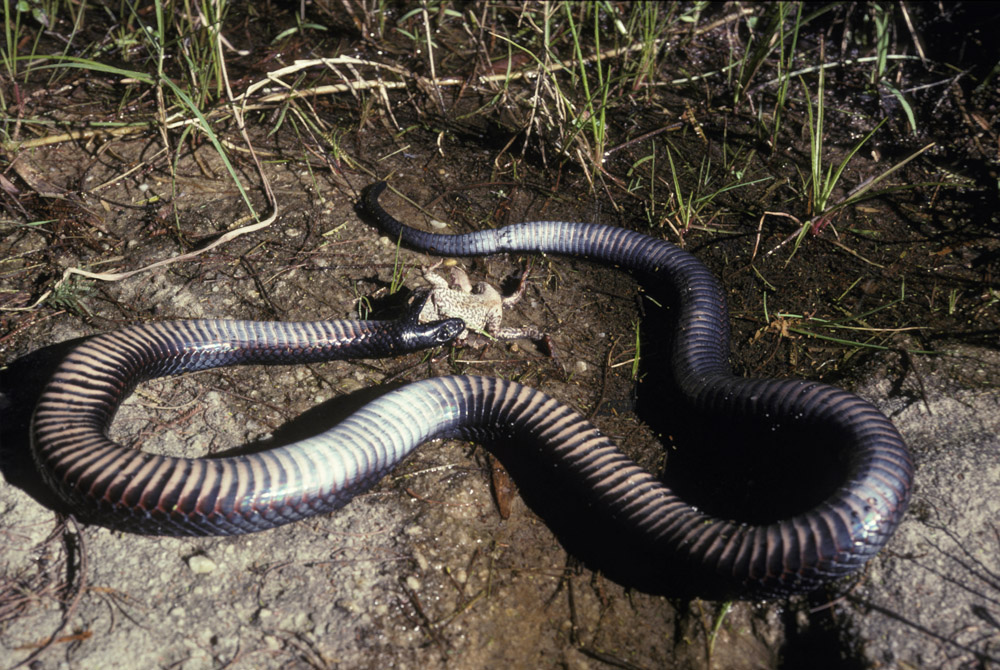
Red-bellied Black Snake poisoned by a cane toad. Photo by Rick Shine.
So, predators large enough to tackle a large adult toad are in big trouble when the toads arrive. Fortunately, things aren’t so awful for most of the smaller species. They don't eat large prey, so they won't tackle a big toad. And if the first toad they meet and eat is a small one, it is more likely to make them feel sick than to kill them. As a result, small predators rapidly learn to leave toads alone.
When the toads first arrived at
Fogg Dam, we found quite a few dead predators, of a range of species.
The most common victims were native tadpoles, who died when they tried
to eat toad eggs. Even for the species most often killed, however, our
surveys showed no real reduction in populations of those animals.
Indeed, many of them increased in abundance, perhaps because of the
lessened risk from big goannas, snakes and the like – the animals that
had been killed by cane toad arrival. Most of the common snake species around Fogg Dam are actually MORE abundant now than they were in the years before cane toads arrived, based on a huge amount of information gathered by Dr Greg Brown in his nightly surveys (walking across the Fogg Dam wall and recording snake numbers just about every night, for several years before and after toads arrived).
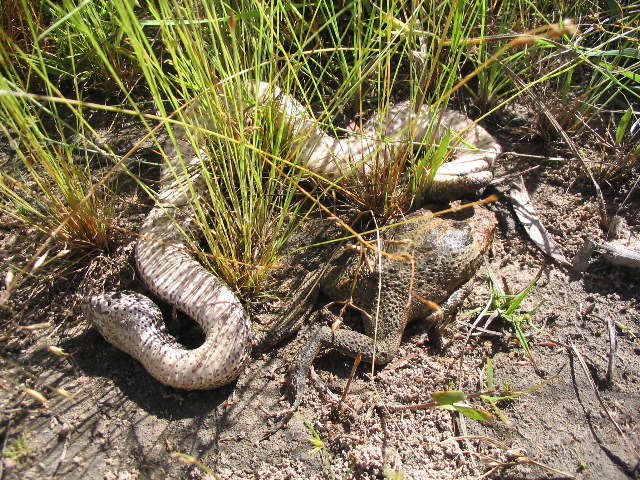
Death Adder killed by a cane toad. Photo by Ben Phillips.
The overall story then, is that when the toads arrive some species (especially big predators) are in real trouble. Others – especially the species that used to be prey for those big predators – probably benefit from the toads’ arrival. And lastly, there’s a lot of species for which toad invasion really doesn’t change much at all. For example, most Australian birds don’t seem to be affected by toads to any significant degree. There are scattered records of a few Australian birds dying after eating cane toads, and one study of toads eating baby birds (rainbow bee-eaters) inside nesting burrows. But the overwhelming majority of Aussie bird species don’t seem to be at any risk from cane toads. Indeed, Christa Beckmann’s work at Fogg Dam has shown that some of the local hawks benefit from toad invasion, because they can scavenge dead toads off the roads. The toads’ poison doesn’t seem to be a problem for most birds, perhaps because of their close evolutionary relationship to birds in Asia, where toads (not cane toads, but species with very similar poisons) are common. Our work in the Kimberley (in collaboration with the Western Australian Department of Environment & Conservation) shows the same situation in many native rodents - they are quite capable of eating a cane toad without becoming ill as a result.
Likewise, keelback snakes can eat all the toads they like without dying. And lots of invertebrates handle the toad’s poison also – sometimes you can see meat ants grabbing and eating huge numbers of tiny toads beside billabongs. A lot of insects that live in the water - like water beetles and waterbugs - actually prefer to eat toad tadpoles rather than frog tadpoles.
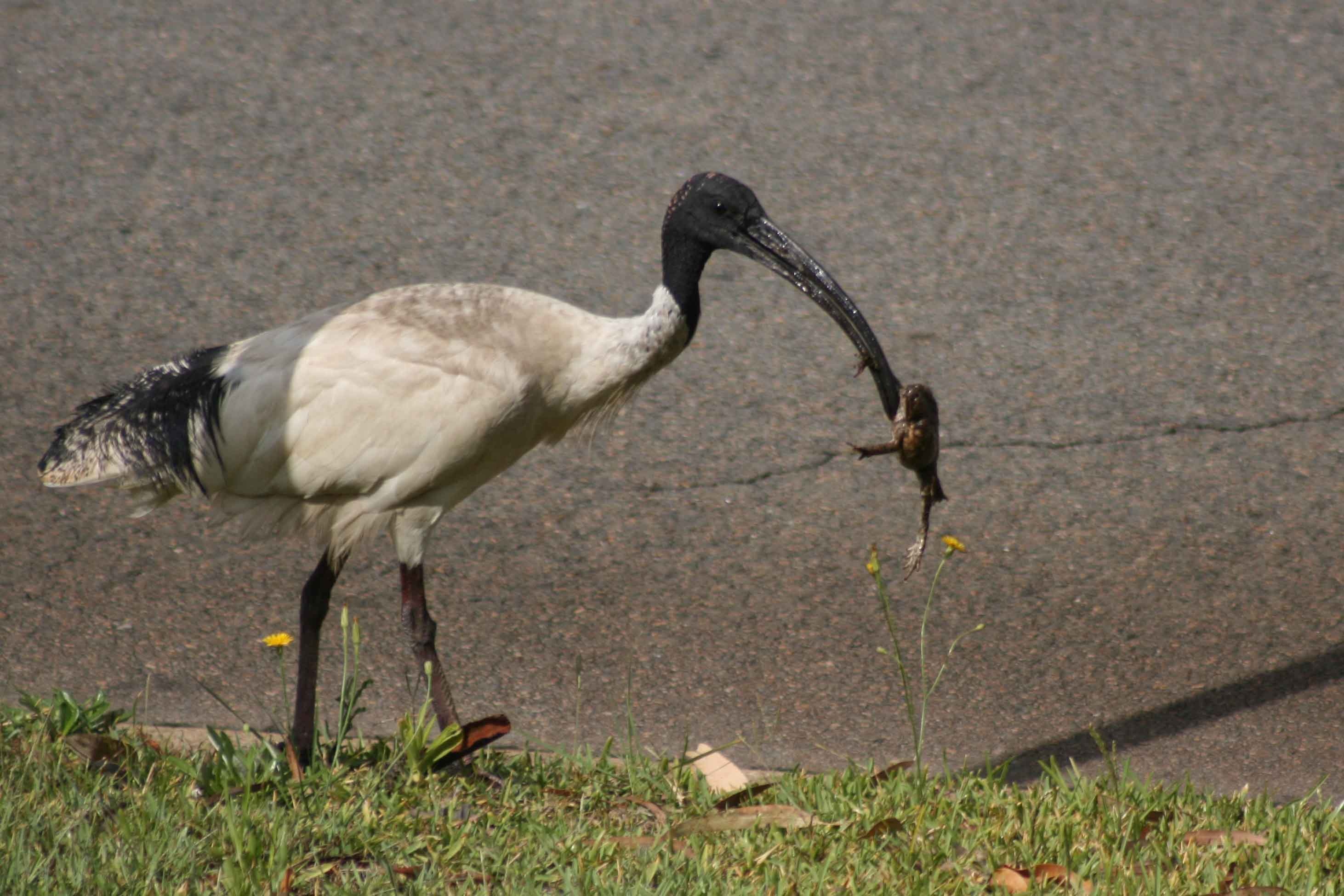
Ibis are able to eat cane toads without a problem. Photo by Jonno Webb.
Overall, no Australian species has gone extinct as a result of cane toads.
When they first arrive in a new area, cane toads kill lots of frog-eating
predators like quolls (carnivorous marsupials), goannas (varanid lizards) and
snakes like death adders, red-bellied blacksnakes and king brown snakes. But
over time, the Australian species adapt to deal with the toad’s presence – so
if you go to places where toads have been around for many decades, most of
those predator species are common again. They may not be as common as they were
before toads arrived – we can’t tell because we don’t have any detailed
information on historical numbers – but they certainly are more common than
they were a few years after the toads arrived.
How do the Australian frog-eating predators change so they can deal with toads?
Two things happen. First is that many species just don’t like the taste of
toads, or feel sick if they eat one but they don’t die – and so they learn to stop
trying to eat things that look like toads. For example, fishes (like
barramundi), frogs (like the Dahl’s Aquatic Frog) and mammals (like planigales)
all learn to avoid toads very quickly.
The second thing that can happen is that even if species don’t learn quickly (perhaps because eating even a small toad is fatal), they can adapt by means of rapid evolutionary change. So, for example, red-bellied blacksnakes are slow learners but nonetheless persist even in areas where toads have occurred for a long time. They achieve this because the only survivors when toads arrive are the few snakes that happen to have genes that say “don’t eat a toad”; or that confer resistance to the toad’s poison. When those survivors reproduce, they pass those characteristics onto their babies – and so, we soon get a population of blacksnakes that can coexist with toads without too many problems.
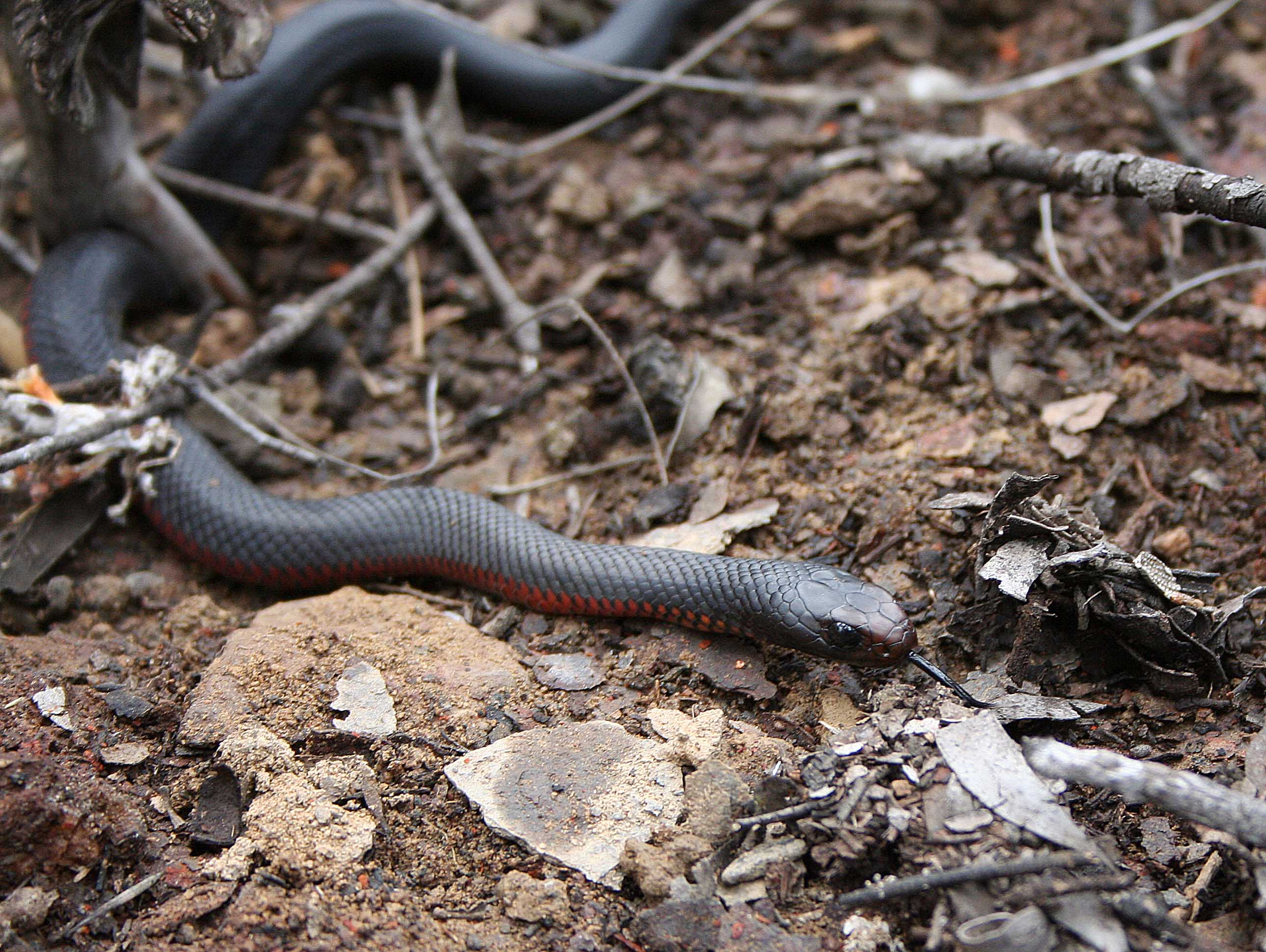
Red-bellied Blacksnakes are evolving to be able to coexist with toads, simply by not trying to eat the poisonous invader. Photo by Sylvain Dubey.
So, cane toads ARE an ecological problem - but only for a fairly small number of species (the big predators) and fortunately, Queensland populations of many of those species (like yellow-spotted goannas and northern quolls) are recovering, a few decades after the toads arrived and really reduced the predator numbers. Our studies in Queensland confirm that species like yellow-spotted goannas learn to avoid toads as food, and so can coexist with toads.
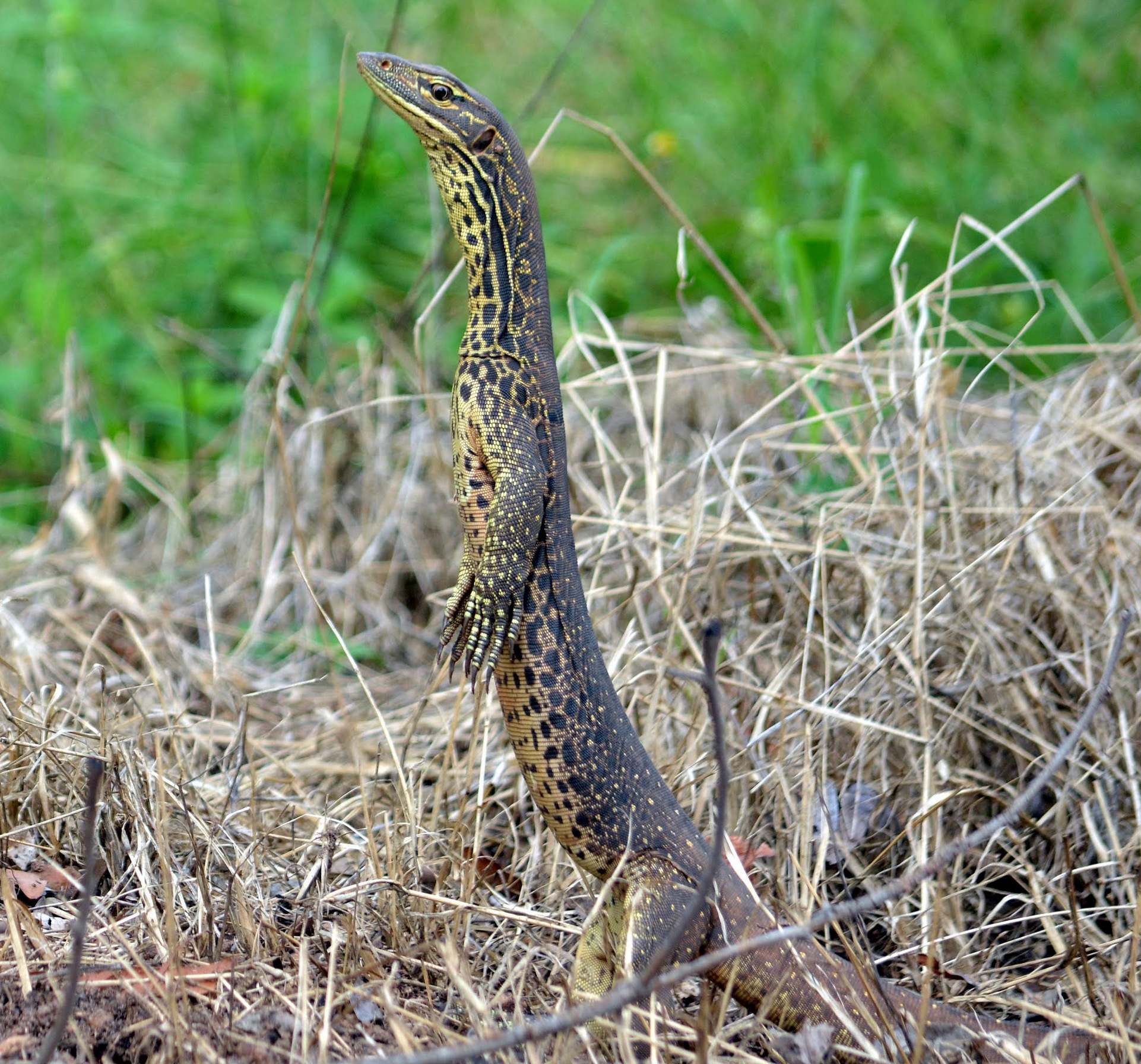
Yellow-spotted monitors are fatally poisoned by toads, and their populations collapse. But they don't go extinct, and instead persist in low abundance by learning not to eat cane toads. Photo by Simon Ducatez.
People learn to live with toads also. Rachael Clarke's work showed that the people most worried about cane toad impact were the ones just in advance of the cane toad invasion front. Once toads arrived, and people began to realize that many of their beloved native species were not really affected, the revulsion against toads began to decrease. It seems like the Australian public, like the Australian wildlife, is learning to live with toads. It would be wonderful if we could get rid of cane toads - but even if we can't, we need to understand that cane toads are just one of many challenges that we have inflicted on the environment - toads are a very real problem, but they are by no means the biggest problem facing our native wildlife.
Return to Home Page
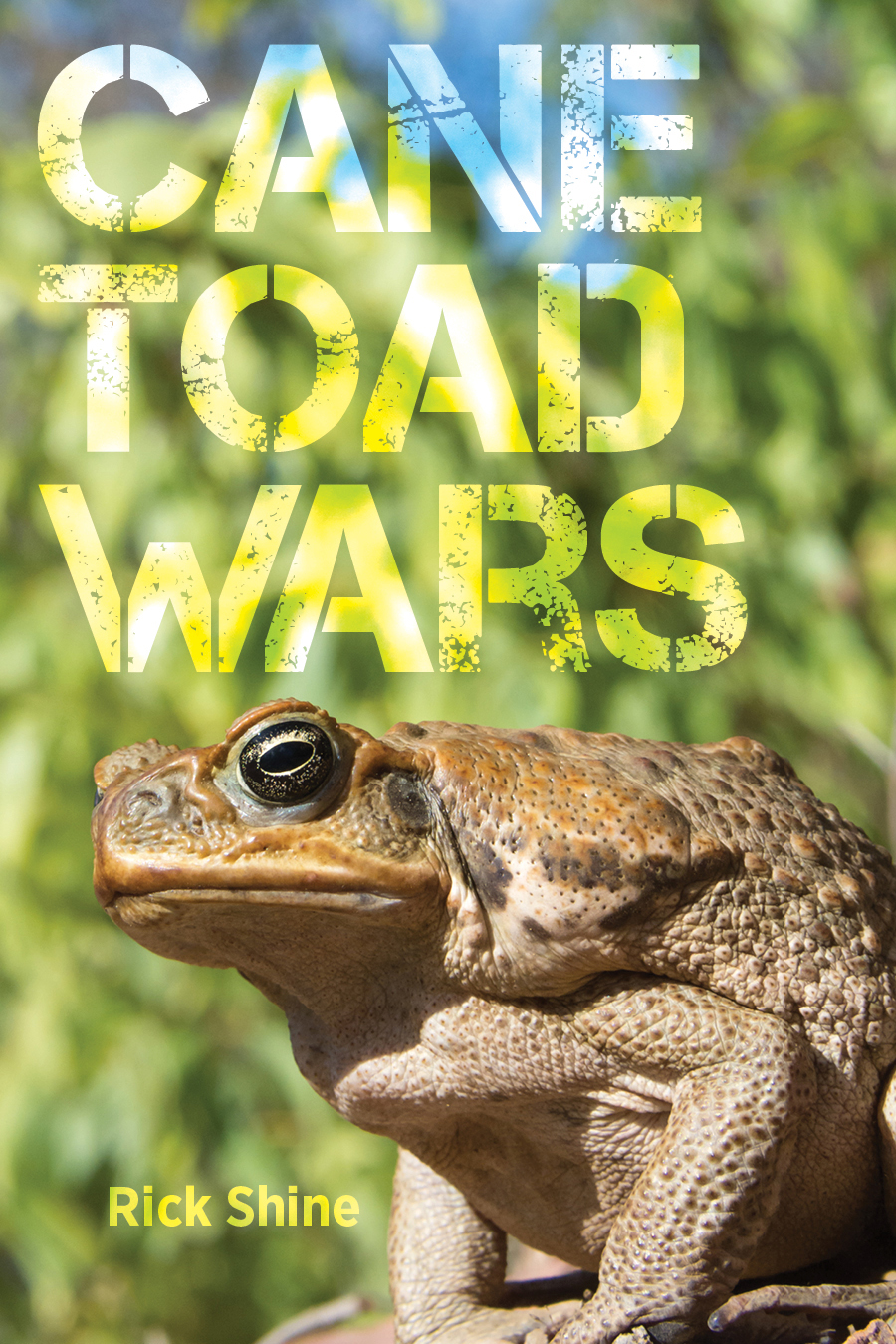
For the full story about the cane toad invasion of Australia, and what we can do about it, read Rick’s book “Cane Toad Wars” (published by University of California Press, 2018). The book is written for the general public, not for scientists, and is aimed at a wide audience. The book can be purchased through online bookstores like Amazon, or you can buy a copy through your local bookstore.
Return to Home Page
